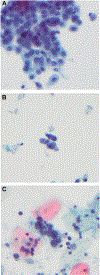Cytology and LGBT+ health: establishing inclusive cancer screening programs
- PMID: 35840516
- PMCID: PMC10132263
- DOI: 10.1016/j.jasc.2022.06.003
Cytology and LGBT+ health: establishing inclusive cancer screening programs
Abstract
There are substantial disparities in cancer screening for sexual minorities and gender non-conforming patients. In additional to patients having trauma due to negative experiences with the healthcare system, disparities may be heightened due to heteronormative and cisnormative design of screening programs and electronic medical record systems. Furthermore, there are morphologic challenges specific to certain specimen types from the LGBT + population, such as anal cytology samples, cervical cytology from transgender men taking testosterone, and neovaginal cytology samples. Men who have sex with men are at increased risk for anal cancer compared with the general population. While early detection of anal dysplasia decreases the risk of invasive carcinoma, screening programs are not widespread. Cervical cancer screening may be psychologically and physically challenging for transgender men and non-binary patients. The use of exogenous testosterone therapy causes atrophic changes in cervical cytology samples which mimic high-grade dysplasia. The rate of unsatisfactory samples are also increased in this population. Although HPV driven cancers have been reported in patients with neovaginas, there are currently no guidelines about appropriate screening for transgender women and intersex patients who have neovaginas. Cytopathologists can optimize the health of LGBT + patients in many ways including advocating for inclusive screening guidelines, validating self-collection for HPV and cytology samples, updating requisition forms to better capture the spectrum of gender expression, and recognizing the morphologic changes in cytology samples due to exogenous hormone use.
Keywords: Anal cytology; Cancer screening; Cervical cytology; Equity; HPV; Transgender health.
Published by Elsevier Inc.
Conflict of interest statement
Conflict of interest
All authors report that they have no conflicts of interest.
Figures


Similar articles
-
Prevalence of high-risk human papillomavirus DNA and mRNA and its association with abnormal anal cytology in the Czech male anal cancer screening cohort.Diagn Cytopathol. 2021 Nov;49(11):1188-1195. doi: 10.1002/dc.24873. Epub 2021 Sep 16. Diagn Cytopathol. 2021. PMID: 34529895
-
Comprehensive Review of Anal Cytology.Acta Cytol. 2023;67(2):185-194. doi: 10.1159/000528532. Epub 2023 Jan 10. Acta Cytol. 2023. PMID: 36626881 Review.
-
Human papillomavirus-associated anal squamous intraepithelial lesions in men who have sex with men and transgender women living with and without HIV in Karachi Pakistan: implications for screening and prevention.BMC Infect Dis. 2021 Nov 17;21(1):1163. doi: 10.1186/s12879-021-06850-w. BMC Infect Dis. 2021. PMID: 34789177 Free PMC article.
-
Evaluation of the validity of the HPV viral load compared to conventional techniques for the detection of high-grade anal intraepithelial lesions in men with HIV who have sex with men.PeerJ. 2023 Aug 23;11:e15878. doi: 10.7717/peerj.15878. eCollection 2023. PeerJ. 2023. PMID: 37637161 Free PMC article.
-
Anal cancer screening and prevention: a review for dermatologists.J Eur Acad Dermatol Venereol. 2021 Aug;35(8):1622-1627. doi: 10.1111/jdv.17263. Epub 2021 Jun 11. J Eur Acad Dermatol Venereol. 2021. PMID: 33797819 Review.
Cited by
-
Mixed methods study of attitudes on location of gynaecological oncology outpatient care: a patient and healthcare professional questionnaire.BMJ Open Qual. 2024 Jan 17;13(1):e002539. doi: 10.1136/bmjoq-2023-002539. BMJ Open Qual. 2024. PMID: 38232984 Free PMC article. Review.
References
-
- Gustafsson L, Pontén J, Zack M, Adami HO. International incidence rates of invasive cervical cancer after introduction of cytological screening. Cancer Causes Control. 1997;8:755–763. - PubMed
-
- Institute of Medicine. The Health of Lesbian, Gay, Bisexual, and Transgender People: Building a Foundation for Better Understanding. Washington, DC: The National Academies Press; 2011. - PubMed
-
- Available at: https://www.lambdalegal.org/sites/default/files/publications/downloads/w.... Accessed October 22, 2021.

